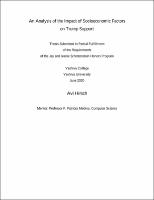Please use this identifier to cite or link to this item:
https://hdl.handle.net/20.500.12202/5608| Title: | An Analysis of the Impact of Socioeconomic Factors on Trump Support . / Avi Hirsch. |
| Authors: | Medina, F. Patricia Hirsch, Avi Yeshiva University, degree granting institution. |
| Keywords: | Senior honors thesis presidential elections Trump, Donald, 1946- |
| Issue Date: | Jun-2020 |
| Publisher: | New York, NY: Yeshiva College. Yeshiva University. |
| Citation: | Hirsch, Avi. (June 2020). An Analysis of the Impact of Socioeconomic Factors on Trump Support.Thesis Submitted in Partial Fulfillment of the Requirements of the Jay and Jeanie Schottenstein Honors Program. Yeshiva College Yeshiva University, June 2020 |
| Abstract: | Presidential elections have always given us opportunities to derive insights into the partisan opinions of the population of the US. When citizens vote for a president, a robust dataset of percounty votes is generated that allows us to analyze percentage support for each party per county. Pundits and media personalities tend to speculate on why certain counties and states support one candidate or the other in each election. Often rigorous analysis of the data in question is ignored in favor of popular opinion and guesses based on a hunch. For this project, I decided to use data science tools to explore the 2016 election as well as several other county-level metrics, such as unemployment and education level. This is a particularly relevant topic now, with the 2020 election approaching. My goal was to focus on support for Donald Trump as a candidate, as opposed to overall support for the GOP. Ultimately, I wished to exclude ordinary partisan lean of counties from my analysis, instead looking at the uniqueness of Trump as a candidate. To do this, I decided to control for GOP support in 2012 (for Mitt Romney), subtracting the overall percentage of people in each county who voted for Romney in 2012 from the overall percentage of people in each county who voted for Trump in 2016. This gave me a new variable that approximated the shift in GOP support from 2012 to 2016. In counties where a greater percentage voted for Trump than Romney, this number would be positive; in counties where a greater percentage voted for Romney, it would be negative. Once I had this metric created, my goal was to isolate which socioeconomic factors were most predictive of this shift in GOP support. I also attempted to predict Trump support using only socioeconomic features in simple linear and logistic models. If the factors I used were predictive of shift in GOP support from 2012 to 2016, the models would find that it could predict this metric for counties it had not yet seen. If there was no correlation between the variables, then they would not be predictive. The research could have ramifications well beyond this immediate project. If models can be developed to predict support for one candidate or the other based solely on socioeconomic indicators (unemployment, education, median household income, etc.), then it could be possible to get a sense for whether Trump would win a future election based solely on the current socioeconomic conditions of each county. Although it presumably would never be a perfect indicator of how Americans will vote, since many other factors are taken into account when voting, it could allow pundits and political analysts to base their predictions on hard data. |
| Description: | Senior honors thesis. YU access only. |
| URI: | https://hdl.handle.net/20.500.12202/5608 |
| Appears in Collections: | Jay and Jeanie Schottenstein Honors Student Theses |
Files in This Item:
| File | Description | Size | Format | |
|---|---|---|---|---|
| Avi Hirsch Honors Thesis.pdf Restricted Access | 827.35 kB | Adobe PDF |  View/Open |
This item is licensed under a Creative Commons License

